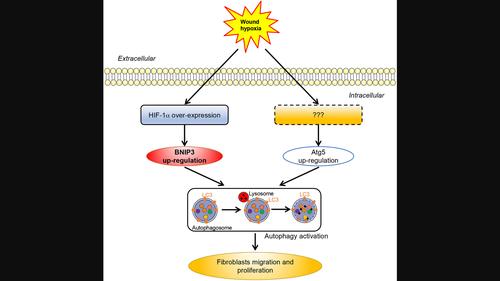Our official English website, www.x-mol.net, welcomes your
feedback! (Note: you will need to create a separate account there.)
Hypoxic microenvironment promotes dermal fibroblast migration and proliferation via a BNIP3-autophagy pathway
The FEBS Journal ( IF 5.5 ) Pub Date : 2023-10-24 , DOI: 10.1111/febs.16985
Can Zhang 1 , Hongmei Li 2 , Min Jiang 1 , Qiong Zhang 3 , Jigang Chen 4 , Jiezhi Jia 3 , Ze Zhang 1 , Huiqing Yu 5 , Jiaping Zhang 1, 3 , Junhui Zhang 3, 5
The FEBS Journal ( IF 5.5 ) Pub Date : 2023-10-24 , DOI: 10.1111/febs.16985
Can Zhang 1 , Hongmei Li 2 , Min Jiang 1 , Qiong Zhang 3 , Jigang Chen 4 , Jiezhi Jia 3 , Ze Zhang 1 , Huiqing Yu 5 , Jiaping Zhang 1, 3 , Junhui Zhang 3, 5
Affiliation

|
Upon injury, nearby cells, including fibroblasts at the wound edge, are often found in a hypoxic microenvironment. Nevertheless, the influence of hypoxia on skin fibroblasts is poorly understood. Using previously established mouse full-thickness wounds, we show that Bcl-2 and adenovirus E1B 19-kDa interacting protein 3 (BNIP3) expression was significantly elevated at the wound edge, and hypoxia treatment enhanced BNIP3 expression in fibroblasts. Interestingly, BNIP3 promoted the migration and proliferation, as well as the activation of autophagy, in fibroblasts under hypoxia. The hypoxia-induced autophagy was found to induce the migration and proliferation of fibroblasts, a process that could be reversed by knocking down the autophagy-related gene for autophagy protein 5, ATG5. Furthermore, hypoxia-inducible factor 1 subunit alpha (HIF-1α) was significantly upregulated in fibroblasts under hypoxia treatment, and HIF-1α knockdown attenuated the hypoxia-induced expression of BNIP3 and the migration and proliferation of fibroblasts. Altogether, our results establish the hypoxia-BNIP3-autophagy signaling axis as a newly identified regulatory mechanism of skin fibroblast migration and proliferation upon wounding. Autophagy intervening might thus represent a promising therapeutic strategy for patients with chronic refractory wounds.
中文翻译:

缺氧微环境通过 BNIP3-自噬途径促进真皮成纤维细胞迁移和增殖
受伤后,附近的细胞(包括伤口边缘的成纤维细胞)通常处于缺氧的微环境中。然而,缺氧对皮肤成纤维细胞的影响知之甚少。使用先前建立的小鼠全层伤口,我们发现伤口边缘的 Bcl-2 和腺病毒 E1B 19-kDa 相互作用蛋白 3 (BNIP3) 表达显着升高,缺氧处理增强了成纤维细胞中的 BNIP3 表达。有趣的是,BNIP3在缺氧条件下促进成纤维细胞的迁移和增殖以及自噬的激活。研究发现缺氧诱导的自噬会诱导成纤维细胞的迁移和增殖,这一过程可以通过敲除自噬相关的自噬蛋白 5 ATG5基因来逆转。此外,缺氧诱导的成纤维细胞中缺氧诱导因子1亚基α(HIF-1α)在缺氧处理下显着上调,并且HIF-1α敲低减弱了缺氧诱导的BNIP3表达以及成纤维细胞的迁移和增殖。总而言之,我们的结果确立了缺氧-BNIP3-自噬信号轴作为新发现的受伤时皮肤成纤维细胞迁移和增殖的调节机制。因此,自噬干预可能代表了慢性难治性伤口患者的一种有前途的治疗策略。
更新日期:2023-10-24
中文翻译:

缺氧微环境通过 BNIP3-自噬途径促进真皮成纤维细胞迁移和增殖
受伤后,附近的细胞(包括伤口边缘的成纤维细胞)通常处于缺氧的微环境中。然而,缺氧对皮肤成纤维细胞的影响知之甚少。使用先前建立的小鼠全层伤口,我们发现伤口边缘的 Bcl-2 和腺病毒 E1B 19-kDa 相互作用蛋白 3 (BNIP3) 表达显着升高,缺氧处理增强了成纤维细胞中的 BNIP3 表达。有趣的是,BNIP3在缺氧条件下促进成纤维细胞的迁移和增殖以及自噬的激活。研究发现缺氧诱导的自噬会诱导成纤维细胞的迁移和增殖,这一过程可以通过敲除自噬相关的自噬蛋白 5 ATG5基因来逆转。此外,缺氧诱导的成纤维细胞中缺氧诱导因子1亚基α(HIF-1α)在缺氧处理下显着上调,并且HIF-1α敲低减弱了缺氧诱导的BNIP3表达以及成纤维细胞的迁移和增殖。总而言之,我们的结果确立了缺氧-BNIP3-自噬信号轴作为新发现的受伤时皮肤成纤维细胞迁移和增殖的调节机制。因此,自噬干预可能代表了慢性难治性伤口患者的一种有前途的治疗策略。































 京公网安备 11010802027423号
京公网安备 11010802027423号